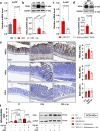Mineralocorticoid receptor activation contributes to intestinal fibrosis through neutrophil gelatinase-associated lipocalin in preclinical models
- PMID: 40634309
- PMCID: PMC12241341
- DOI: 10.1038/s41467-025-61401-0
Mineralocorticoid receptor activation contributes to intestinal fibrosis through neutrophil gelatinase-associated lipocalin in preclinical models
Abstract
Intestinal fibrosis is a common complication in inflammatory bowel diseases with no specific therapy. Because mineralocorticoid receptor antagonism prevented inflammation and fibrosis in extra-intestinal organs, we aimed to evaluate mineralocorticoid receptor antagonism in intestinal fibrosis. Here we show that pharmacological or smooth cell specific deletion mineralocorticoid receptor antagonism prevented colon fibrosis development in male mice. In vitro, spironolactone prevented fibroblast proliferation and endothelial-to-mesenchymal transition. Neutrophil gelatinase-associated lipocalin silencing suppressed aldosterone-induced fibrosis markers and blunted colon fibrosis in mice. Chromatin immunoprecipitation showed mineralocorticoid receptor antagonist inhibits mineralocorticoid receptor binding on the neutrophil gelatinase-associated lipocalin promoter in activated smooth muscle cells. In conclusion, mineralocorticoid receptor antagonism or smooth muscle mineralocorticoid receptor deletion reduced colon fibrosis through the modulation of the neutrophil gelatinase-associated lipocalin pathway. Mineralocorticoid receptor may represent a novel therapeutic target in intestinal fibrosis and may allow the re-positioning in the field of inflammatory bowel diseases of drugs already marketed.
© 2025. The Author(s).
Conflict of interest statement
Competing interests: The authors declare no competing interests.
Figures










References
-
- D’Alessio, S. et al. Revisiting fibrosis in inflammatory bowel disease: the gut thickens. Nat. Rev. Gastroenterol. Hepatol.19, 169–184 (2022). - PubMed
-
- Moran, G. W. et al. Phenotypic features of crohn’s disease associated with failure of medical treatment. Clin. Gastroenterol. Hepatol.12, 434–442.e431 (2014). - PubMed
MeSH terms
Substances
Grants and funding
LinkOut - more resources
Full Text Sources

